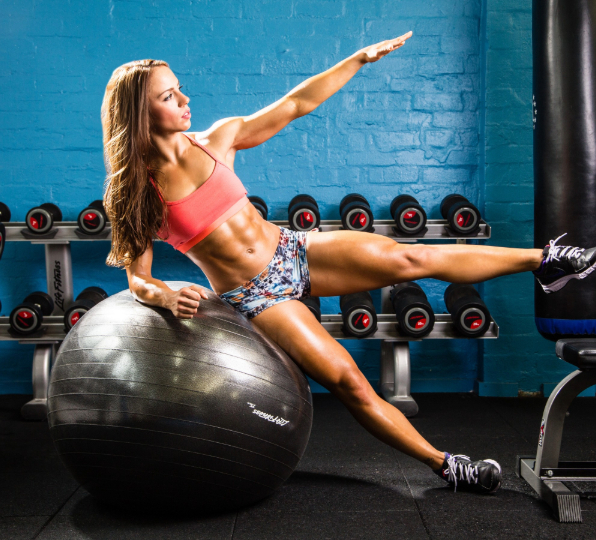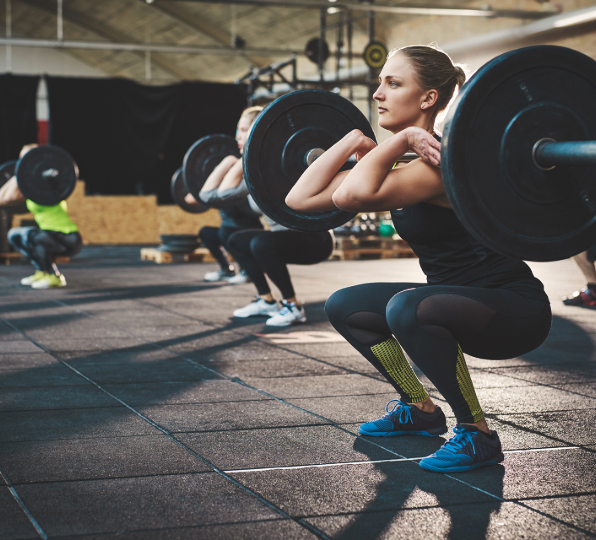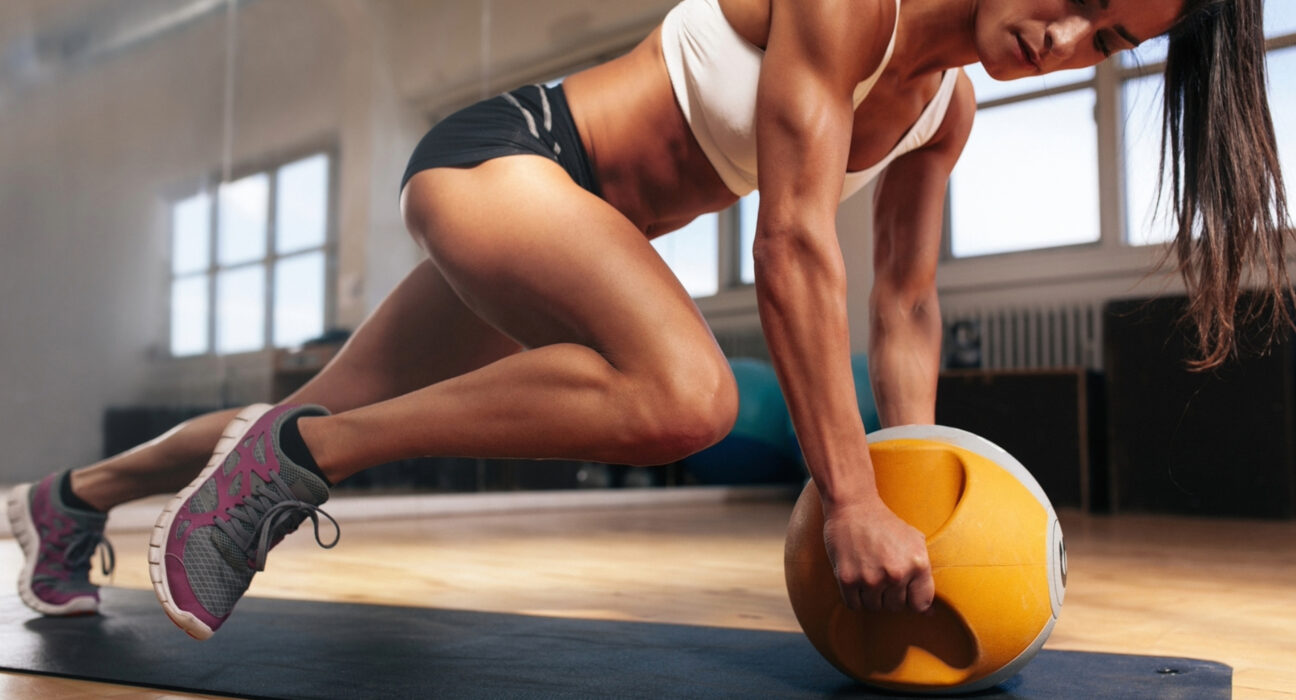Introduction:
It takes a combination of cardiovascular exercise, strength training, and healthy diet to achieve a toned and sculpted physique. This blog post will go over ten efficient workouts that will help you tone and strengthen every major muscle group in your body. Including these exercises in your workout regimen can help you reach your fitness objectives and develop a lean, muscular body, regardless of your level of experience.
1. Squats
Squats are a foundational compound exercise renowned for their effectiveness in targeting multiple muscle groups simultaneously, making them a staple in strength training routines. This exercise primarily engages the quadriceps, hamstrings, glutes, and core muscles, offering a comprehensive lower body and core workout.
To perform a squat with proper form and maximize its benefits, follow these steps:
- Set Up: Begin by standing with your feet shoulder-width apart, ensuring that your feet are pointing slightly outward. Keep your chest up and shoulders back to maintain a straight and neutral spine. Engage your core muscles to stabilize your torso throughout the movement.
- Initiate the Descent: Lower your body by bending your knees and pushing your hips back, as if you are sitting back into an imaginary chair. It’s crucial to maintain a controlled descent, ensuring that your knees track in line with your toes and do not collapse inward. This helps to distribute the load evenly across your lower body and minimizes the risk of injury.
- Lowering Phase: Continue descending until your thighs are parallel to the ground, or as close to parallel as your mobility allows. Aim to achieve a full range of motion while maintaining proper form. Keep your chest lifted and avoid rounding your back, as this can place unnecessary stress on your spine.
- Ascent Phase: Once you have reached the bottom position of the squat, push through your heels to drive your body back up to the starting position. Focus on engaging your quadriceps, hamstrings, and glutes to powerfully extend your hips and knees. Keep your core tight to maintain stability throughout the movement.
- Complete the Repetition: Return to the standing position, ensuring that your hips fully extend at the top of the movement. Squeeze your glutes at the top to maximize activation of the posterior chain muscles. Take a brief pause before beginning the next repetition to reset and maintain control over the movement.
Incorporating squats into your fitness routine can offer numerous benefits, including increased lower body strength, improved muscle tone, enhanced functional movement patterns, and greater overall athleticism. As with any exercise, it’s essential to start with light weights or body weight and gradually increase the intensity as your strength and technique improve. Additionally, if you have any pre-existing injuries or mobility limitations, consult with a fitness professional to ensure that squats are appropriate for your individual needs and goals.
2. Push-Ups
Push-ups are a classic bodyweight exercise that effectively targets multiple muscle groups, including the chest, shoulders, triceps, and core. Incorporating push-ups into your workout routine can help build upper body strength, improve muscular endurance, and enhance overall functional fitness.
To perform a proper push-up, start by assuming a plank position with your hands placed slightly wider than shoulder-width apart and your arms fully extended. Your body should form a straight line from your head to your heels, engaging your core muscles to maintain stability. Ensure that your hands are positioned directly under your shoulders to maintain proper alignment throughout the movement.
As you lower your body towards the ground, focus on keeping your elbows close to your sides to target the chest, shoulders, and triceps effectively. Avoid letting your elbows flare outwards, as this can place unnecessary stress on the shoulder joints and increase the risk of injury. Lower yourself until your chest nearly touches the ground while maintaining a straight back and engaged core muscles.
Once you have reached the bottom of the movement, pause briefly before pushing back up to the starting position. Exhale as you press through your palms and extend your arms, fully engaging your chest, shoulders, and triceps to lift your body back up. Keep your core muscles activated throughout the entire movement to stabilize your body and maintain proper form.
It’s essential to perform push-ups with control and precision to maximize their effectiveness and reduce the risk of injury. Focus on maintaining a slow and controlled tempo, emphasizing proper form and technique throughout each repetition. If you find push-ups too challenging initially, you can modify the exercise by performing them on your knees or against an elevated surface, such as a bench or countertop, until you build up the strength to perform full push-ups.
Incorporate push-ups into your workout routine regularly to reap the benefits of this versatile exercise. You can vary the intensity and difficulty by adjusting hand placement, incorporating variations such as wide-grip or narrow-grip push-ups, or adding external resistance, such as a weight vest or resistance bands. Whether you’re a beginner or an advanced athlete, push-ups are an effective way to build upper body strength, improve muscular endurance, and enhance overall physical fitness.
3. Lunges
Walking lunges are a dynamic lower body exercise that targets several muscle groups, including the quadriceps, hamstrings, glutes, and calves. Incorporating walking lunges into your workout routine can help improve lower body strength, enhance muscular endurance, and increase overall stability and balance.
To perform walking lunges correctly, follow these steps:
- Starting Position: Begin by standing upright with your feet hip-width apart and your hands on your hips or by your sides. Engage your core muscles to stabilize your spine and maintain proper posture throughout the exercise.
- Initiate the Movement: Take a step forward with one foot, ensuring that your stride is long enough to allow both knees to bend at a 90-degree angle when you lower your body. The back knee should hover just above the ground, and the front knee should be positioned directly above the ankle.
- Lower Your Body: As you step forward, lower your body towards the ground by bending both knees simultaneously. Keep your torso upright and your chest lifted, avoiding leaning forward or rounding your back. Aim to lower yourself until both knees are bent at a 90-degree angle, with the back knee hovering just above the ground.
- Push Through the Front Heel: Once you reach the bottom of the lunge position, push through the heel of your front foot to drive yourself back up to the starting position. Use the strength of your quadriceps, hamstrings, and glutes to propel yourself forward and return to a standing position.
- Repeat on the Other Side: After completing the lunge on one side, step forward with the opposite foot and repeat the same movement pattern. Alternate between legs, taking a step with each lunge, to perform walking lunges continuously.
It’s essential to maintain proper form and technique throughout the exercise to maximize its effectiveness and reduce the risk of injury. Keep your knees aligned with your toes, avoid letting them collapse inward or outward, and ensure that your movements are controlled and deliberate.
To increase the intensity of walking lunges, you can incorporate additional resistance by holding dumbbells or a barbell across your shoulders. Alternatively, you can perform walking lunges on an incline or decline surface to challenge your balance and stability further.
Icorporate walking lunges into your lower body workout routine to target multiple muscle groups simultaneously and enhance overall lower body strength, stability, and balance. Whether you’re a beginner or an experienced athlete, walking lunges are a versatile exercise that can be adapted to suit your fitness level and goals.
4. Deadlifts
Deadlifts are a fundamental compound exercise that targets several major muscle groups, including the hamstrings, glutes, lower back, and core. Incorporating deadlifts into your workout routine can help improve overall strength, enhance muscular development, and promote functional movement patterns.
To perform a conventional deadlift correctly, follow these steps:
- Starting Position: Begin by standing with your feet hip-width apart, with the barbell positioned directly over the middle of your feet. Your toes should be pointing forward or slightly outward, and your shins should be in light contact with the barbell. Bend your knees slightly and grasp the barbell with an overhand grip, hands positioned just outside of your knees.
- Engage Your Core: Before initiating the lift, engage your core muscles to stabilize your spine and maintain proper alignment throughout the movement. Keep your chest up, shoulders back, and maintain a neutral spine position to minimize the risk of injury.
- Initiate the Lift: With your arms fully extended, hinge at the hips and lower your torso towards the ground while keeping your back flat and maintaining a slight bend in your knees. Focus on pushing your hips back and keeping the weight in your heels to activate the posterior chain muscles, including the hamstrings and glutes.
- Drive Through Your Heels: Once you reach the bottom of the movement with the barbell just below knee level, push through your heels to drive your hips forward and lift the barbell off the ground. Maintain a strong grip on the barbell and keep it close to your body throughout the lift to optimize leverage and stability.
- Squeeze Your Glutes: As you lift the barbell off the ground, focus on squeezing your glutes at the top of the movement to fully engage the posterior chain muscles. Keep your shoulders pulled back and your chest lifted as you reach the top position, maintaining a straight line from your head to your heels.
- Lower with Control: Reverse the movement by lowering the barbell back down towards the ground in a controlled manner, maintaining proper form and alignment. Avoid rounding your back or allowing the barbell to drift away from your body during the descent.
Deadlifts can be performed using various equipment, including barbells, dumbbells, or kettlebells, allowing for versatility in training. Additionally, deadlift variations such as sumo deadlifts or Romanian deadlifts can target different muscle groups or emphasize specific aspects of the lift.
5. Planks
Planks are a highly effective isometric exercise that targets the core muscles along with engaging the shoulders, chest, and back. Incorporating planks into your workout routine can help strengthen the entire core region, improve posture, and enhance overall stability and endurance.
To perform a plank correctly, follow these steps:
- Starting Position: Begin by positioning yourself face down on the floor, with your elbows bent and directly under your shoulders. Your forearms should be flat on the ground, and your hands should be relaxed. Extend your legs behind you, resting on the balls of your feet, and align your body in a straight line from your head to your heels.
- Engage Your Core: Before lifting your body off the ground, engage your core muscles by drawing your navel towards your spine and bracing your abdominals. This action will help stabilize your spine and pelvis, allowing you to maintain proper alignment throughout the exercise.
- Lift Your Body: Push through your forearms and toes to lift your body off the ground, maintaining a straight line from head to heels. Keep your hips level with the rest of your body and avoid allowing them to sag towards the ground or lift towards the ceiling. Engage your glutes and leg muscles to support your lower body and maintain stability.
- Hold the Position: Once you have lifted into the plank position, hold it for as long as possible while maintaining proper form. Focus on breathing deeply and evenly to help support your muscles and control your body position. Aim to keep your shoulders relaxed and your neck in line with your spine to prevent unnecessary tension or strain.
- Monitor Your Form: Throughout the plank, pay close attention to your form and technique. Avoid overarching or rounding your back, as this can place excessive stress on the spine and lead to discomfort or injury. Instead, strive to maintain a neutral spine position with a slight natural curve in the lower back.
- Gradually Increase Duration: As you become more proficient with the plank exercise, aim to gradually increase the duration of your holds. Start with shorter holds, such as 15-30 seconds, and gradually work your way up to longer holds of 60 seconds or more as your strength and endurance improve.
Planks can be modified to suit different fitness levels and goals. Beginners may start with a modified plank on their knees, while advanced individuals can incorporate variations such as side planks, plank jacks, or plank with leg lifts to increase the challenge
6. Dumbbell Rows
Dumbbell rows are a highly effective compound exercise primarily targeting the muscles of the back, including the latissimus dorsi, rhomboids, and traps, as well as the biceps and shoulders. Incorporating dumbbell rows into your workout routine can help improve back strength, enhance muscle definition, and promote better posture and shoulder stability.
To perform dumbbell rows with proper form, follow these steps:
- Set-Up: Begin by selecting an appropriate pair of dumbbells that allow you to maintain proper form while performing the exercise. Stand with your feet shoulder-width apart, holding a dumbbell in each hand with an overhand grip (palms facing your body). Keep your knees slightly bent and hinge forward at the hips to bring your torso parallel to the ground. Ensure that your back is flat, and your chest is up, maintaining a neutral spine position throughout the movement.
- Engage Your Core: Before initiating the rowing motion, engage your core muscles to stabilize your spine and maintain proper alignment. Keep your shoulders pulled back and down, away from your ears, to promote shoulder stability and prevent shrugging.
- Perform the Row: With your elbows bent and tucked close to your sides, exhale as you pull the dumbbells towards your ribcage, driving your elbows back and squeezing your shoulder blades together at the top of the movement. Focus on initiating the row with your back muscles rather than relying solely on your arms to lift the weights. Keep your wrists straight and avoid excessive swinging or momentum.
- Control the Descent: In a slow and controlled manner, inhale as you lower the dumbbells back towards the starting position, maintaining tension in your back muscles throughout the eccentric (lowering) phase of the exercise. Avoid fully extending your arms at the bottom of the movement to keep constant tension on the targeted muscles.
- Repeat: Complete the desired number of repetitions on one side before switching to the other side. Aim to perform the exercise with smooth, controlled movements, focusing on quality over quantity.
Dumbbell rows can be performed using various grip variations, such as neutral grip or underhand grip, to target different areas of the back and arms. Additionally, adjusting the angle of your torso (more upright or more horizontal) can alter the emphasis on specific muscles within the back.
7. Burpees
Burpees are a dynamic and challenging full-body exercise that targets multiple muscle groups simultaneously, including the legs, chest, shoulders, arms, and core. This high-intensity exercise is known for its ability to improve cardiovascular fitness, enhance muscular endurance, and promote calorie burning, making it a popular choice for both strength training and cardiovascular conditioning.
To perform burpees correctly, follow these steps:
- Starting Position: Begin by standing with your feet hip-width apart and your arms by your sides. Engage your core muscles to stabilize your spine and maintain proper posture throughout the exercise. This is your starting position.
- Squat Down: Lower your body into a squat position by bending your knees and pushing your hips back as if you were sitting back into a chair. Keep your chest up and your weight in your heels to maintain balance and stability.
- Plank Position: From the squat position, place your hands on the ground in front of you, shoulder-width apart. Shift your weight onto your hands and jump or step your feet back into a plank position, with your body forming a straight line from head to heels. Engage your core muscles to keep your hips level and prevent sagging or lifting.
- Push-Up: Once in the plank position, lower your chest towards the ground by bending your elbows, keeping them close to your body. Perform a push-up by lowering yourself until your chest nearly touches the ground, then push through your palms to return to the plank position. If performing a full push-up is challenging, you can modify by dropping your knees to the ground before performing the push-up.
- Jump Forward: After completing the push-up, jump or step your feet back towards your hands, returning to the squat position. Keep your weight in your heels and your chest up as you bring your feet forward.
- Jump Up: Finally, explosively jump up into the air, extending your arms overhead to reach towards the sky. As you jump, straighten your legs and fully extend your hips to propel yourself upwards. Land softly on the balls of your feet and immediately lower back into the next repetition to continue the exercise.
Burpees can be performed at a fast pace for a cardiovascular challenge or at a slower pace for a more controlled strength-focused workout. They can also be modified to suit different fitness levels by adjusting the intensity of each component, such as performing a step instead of a jump or omitting the push-up for beginners.


Conclusion:
Incorporating these 7 exercises into your workout routine can help you tone and strengthen every inch of your body, from head to toe. Remember to focus on proper form, gradually increase the intensity and challenge as you progress, and combine these exercises with a balanced diet and adequate rest for optimal results. With consistency and dedication, you can achieve a lean, sculpted physique and enjoy the numerous benefits of a regular exercise routine.












